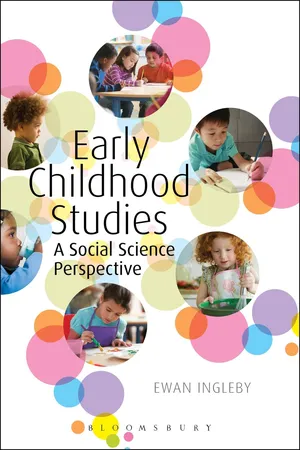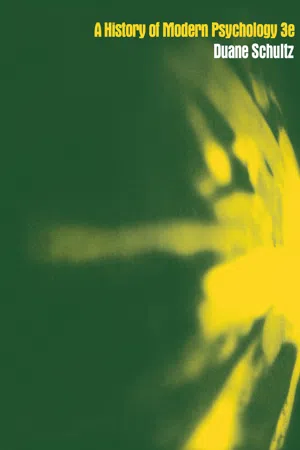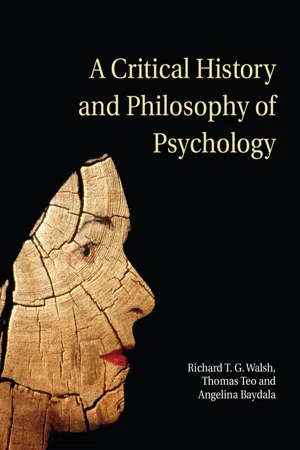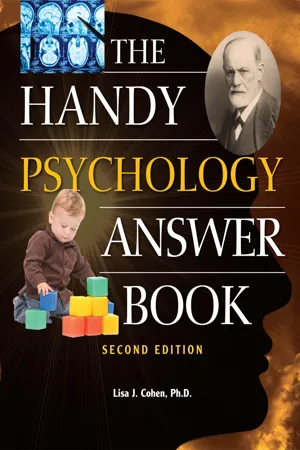Psychology
Schools of Thought
Schools of thought in psychology refer to the various theoretical perspectives and approaches used to understand and explain human behavior and mental processes. These schools of thought include behaviorism, psychoanalysis, humanism, cognitive psychology, and others, each with its own unique principles and methods for studying the mind and behavior.
Written by Perlego with AI-assistance
Related key terms
1 of 5
5 Key excerpts on "Schools of Thought"
- eBook - PDF
Early Childhood Studies
A Social Science Perspective
- Ewan Ingleby(Author)
- 2012(Publication Date)
- Bloomsbury Academic(Publisher)
The origins of the Schools of Thought go back to some of the earliest philosophical ideas to have influenced Western Psychology and Early Childhood Studies 9 thought. The proposition that there are forces beyond the individual that shape social reality goes back to the ideas of the Greek philosopher Plato. This idea is central to behaviourism so the perspective has its intellectual origins in this classical thought. The notion that individuals interpret their social world as opposed to being ultimately shaped by this world goes back to the ideas of Aristotle (Audi, 1995). This philosophy is of central impor-tance to humanism. In other words the genesis of the perspective’s domi-nant idea can be traced back to these early times. A summary of each of the key perspectives developing the definitions given in Table 1.1 follows. A definition of each of the key perspectives is given, key figures influencing the perspective are identified and central terms within each perspective are explained. Behaviourism Behaviourists emphasize the importance of external factors in producing thoughts within the human mind. A key behaviourist idea is that every indi-vidual enters the world as a ‘clean slate’. The surrounding environment is considered to be the ‘chalk’ etching its marks upon the ‘slate’ of the mind. This means that the individual enters the world without a fixed identity and that social factors are responsible for making the individual whosoever she/ Table 1.1 Schools of psychology School Key features Behaviourism Human behaviour is seen as being shaped by environmental forces and is a collection of learned responses to external stimuli. The key learning process is known as ‘conditioning’. Humanism The individual is seen as being unique, rational and self-determining. Present experience is held to be as important as past experience. Psychodynamic theory The mind is seen as being a combination of conscious thoughts and the workings of the unconscious mind. - eBook - PDF
- Duane Schultz(Author)
- 2013(Publication Date)
- Academic Press(Publisher)
w MORE RECENT DEVELOPMENTS Schools of Thought IN PSYCHOLOGY Throughout this book we have described how the major Schools of Thought in psychology came into being, prospered for a time, and then (with the exception of psychoanalysis) became part of the mainstream of contemporary American psychology, or at least contributed to it. We have also seen that each movement grew strong and vital through its opposition to another system. When there was no longer any need for protest—when the new school had vanquished its opposition—that school died as a movement and became an established position, at least for a time. Each of the Schools of Thought was successful; each made substantial contributions to psychological thought. Each, therefore, was a fruitful protest and accomplished its mission. This is true even for structuralism, although it left little direct imprint on the contemporary psychological scene. There are no longer structuralists of the Wundtian variety in psychology, nor have there been for decades. Yet structuralism was an enormous success. It accomplished exactly what it set out to do: it established an independent science of psychology that was finally free of philosophy. That it failed to remain the dominant position in psychology for more than a short time does not detract from its revolutionary achievement as the founding school of a new science. Consider the success of functionalism, which also has not lasted as a separate school of thought. As an attitude, a point of view—which was all it hoped to be—functionalism has permeated contemporary American psy-chological thought. To the extent that American psychology today is as much profession as science, and is applying its findings to virtually every aspect of life, the functional, utilitarian viewpoint has won a great many converts. Whether this applied-professional orientation will be to the ulti-mate benefit of psychology is being debated. - Lorelle J. Burton, Drew Westen, Robin M. Kowalski(Authors)
- 2022(Publication Date)
- Wiley(Publisher)
In this chapter and throughout the text, we examine five perspectives that guide current psychological thinking, offering sometimes competing and sometimes complementary points of view. These perspectives offer the same kind of broad, orienting approach as a scientific paradigm, and they share its three essential features. Focusing on these perspectives does not mean that other less comprehensive approaches have not contributed to psychological knowledge or that nothing can be studied without them. These five perspectives generally guide psychological investigations and therapeutic interventions. APPLY AND DISCUSS • To what extent has integration between the different theoretical perspectives occurred? • What are the main benefts of an approach that accepts many behaviourist principles but also emphasises the role of thought processes in learning? In the following sections, we examine the psychodynamic, behaviourist, humanistic, cognitive and evolutionary perspectives. In many respects, these perspectives have evolved independently, and at the centre of each are phenomena the others tend to ignore. INTERIM SUMMARY A paradigm is a broad system of theoretical assump- tions employed by a scientifc community that includes a distinct set of concepts or thought patterns, and shared metaphors and research methods. Psychology lacks a unifed paradigm but has a number of Schools of Thought, or perspectives, that can be used to understand psycho- logical events. The psychodynamic perspective A friend has been going out with a man for five months and has even jokingly tossed around the idea of marriage. Suddenly, her boyfriend tells her he has found someone else. She is shocked and cries uncontrollably but a day later declares that ‘he didn’t mean that much to me anyway’.- eBook - PDF
A Critical History and Philosophy of Psychology
Diversity of Context, Thought, and Practice
- Richard T. G. Walsh, Thomas Teo, Angelina Baydala(Authors)
- 2014(Publication Date)
- Cambridge University Press(Publisher)
Founding psychologists proposed broad explanations encompassing the gamut of psycho-logical processes rather than theories speci fi c to particular phenomena. The principal Schools of Thought in early Psychology were voluntarism, structuralism, re fl exology, Part 2 Schools of Thought 213 functionalism, social practice, self theory, and hormic theory. Gestalt theory (see Chapter 6 ) and psychoanalysis (see Chapter 9 ) did not become prominent until after World War I. Voluntarism Wilhelm Wundt used experimental methods to address philosophical questions related to sensory functioning and body – mind relations and establish universal truths about the mind. He extended physiological understanding to psychological functions, based on the philo-sophical concept of apperception. Wundt ’ s focus for investigating psychological causality was the individual ’ s active response. Hence, his school of thought quali fi ed as a form of voluntarism because, for him, thinking constituted an internal choice (Kusch, 1999 ). Nineteenth-century psychologists often presented their attempts at explaining action, as distinct from passive responding, in terms of the concept of volition. This concept covered a great deal of what would later be discussed in terms of the psychology of drives and motives . . . Wundt played a signi fi cant role in preparing for this change. (Danziger, 2001b , p. 97) Basic concepts During the 1880s with tests of muscular reaction and reaction time, Wundt observed “ automatization, ” meaning automatic reactions to sensory stimuli. By varying the required response in testing conditions he mapped simple (lower) to complex (higher) voluntary activity. He concluded that aspects of complex mental processes function together, with higher functions (e.g., attention) evolving from lower ones (e.g., re fl exes). Therefore, studying mere elements of consciousness (i.e., awareness of simple sensations), he believed, can provide partial insight only. - eBook - PDF
- Lisa J. Cohen(Author)
- 2016(Publication Date)
- Visible Ink Press(Publisher)
Gestalt therapy is commonly considered part of humanistic psychology and incorporates principles from the philosophical schools of phenomenology and existentialism as well as psychoanalysis and Gestalt psychology. What is psychoanalytic theory? While behaviorism dominated American academic psychology throughout the first half of the twentieth century, psychoanalysis dominated clinical psychology—the study of abnormal psychology—during the same period both in Europe and the United States. Psychoanalysis was so prominent because it provided a comprehensive theory of psychopathology and a psychological method of treating mental distress. It is fair to say that most, if not all, subsequent theories of psychopathology and psychotherapy owe an enormous debt to psychoanalysis. Although many schools of psychotherapy were formed in reaction to psychoanalysis, they were still defined in response to it and therefore must be seen as its descendants. Psychoanalytic theory actually includes a broad range of theoretical writing, starting with Sigmund Freud’s original contributions in the late nineteenth century. Since Freud, psychoanalysis has broken into numerous schools including ego psychology, interpersonal psychoanalysis, and the object relations school, all of which developed in the mid-twentieth century. More recent schools include self-psychology and relational theory. What is Freud’s topological model? In Freud’s topological model, the mind is divided into three sections, the unconscious, the pre-conscious, and the conscious. In the unconscious, the individual is not aware of the contents of the mind. Here, forbidden and dangerous wishes reside, safely out of awareness. In the pre-conscious, mental content is capable of entering into consciousness but is not currently there. There is no block between conscious and pre-conscious as there is between the conscious and the unconscious. The conscious part of the mind contains all the mental content that is in our awareness.
Index pages curate the most relevant extracts from our library of academic textbooks. They’ve been created using an in-house natural language model (NLM), each adding context and meaning to key research topics.




